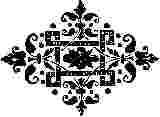
Part II
The Patience of the Saints
The Lord’s people have understood what must yet
come to pass, but have suffered uncertainty with regard to this vision. The saints watched
the Evangelical Alliance rise and fall and also have witnessed the World Council of
Churches emerge in 1948 and then flounder trying to bring social justice to third world
nations.
It is easy to become confused and uncertain. The feeling may arise that
we have followed our imaginations rather than the sure word of prophecy. The answer is no,
we have not. This vision is true and certain and will surely come to pass. Have no doubt
about it. The mills of God grind very slowly, but exceedingly fine.
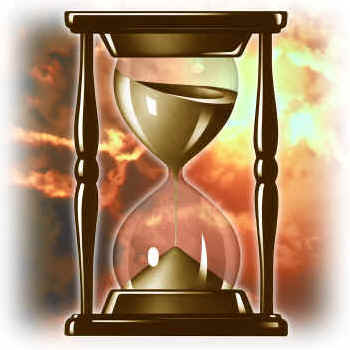
|
Time is
an important ingredient in all God’s dealings, and the test of time has defeated many
of God’s people throughout the age.
"He that shall endure unto the end, the same shall be saved"
is still a certain promise.
Matthew 24:13
|
Prophecy must always be considered with the realization that we may
need to make adjustments as events develop and come to fulfillment. How all the
particulars will play out, no one may know in detail beforehand. As Paul said, "We
see through a glass, darkly"
(1 Corinthians 13:12).
Some have used this scripture to imply that we are looking through
opaque glass and, therefore, we see nothing. That is not what is says. Looking through a
dark glass provides an overview of events, but some of the finer features cannot be
distinguished. Dark sunglasses are still very popular. They limit the light, but also
reduce eyestrain. Let us keep looking "through a glass, darkly."

What Is God’s Anticipated
Response
to the "Image" Worshipers?
Revelation 13:16, 17 left us facing a mean and threatening
"image of the beast." The story does not end there. Revelation has many
interrupted stories, so the reader has to read through several different visions before
the story is rejoined. Such is the case with this "image" story. Revelation 14:9,
10
says,
"And the third angel followed them, saying with a loud voice, If any man
worship the beast and his image, and receive his mark in his forehead, or in his hand, the
same shall drink of the wine of the wrath of God, which is poured out without mixture into
the cup of his indignation."
The third angel is probably the message of warning that came early
in the harvest in THE BATTLE OF ARMAGEDDON, predicting the rise of this
"image" and its activities.
God anticipated the creation of this "image" and its
receiving "life." He warned his saints beforehand to be prepared in mind and
heart to resist unto death identifying with either the "beast" or its
"image." God will not have his people yield to this Protestant and Catholic
conspiracy.
If any of his saints should be deceived into cooperation on any level
with this religious conspiracy, they will suffer the consequences by sharing in the
"plagues" coming upon Babylon. They will also have eternity to regret this
deflection on their part.
It is certain that anyone who yields to the beast or its image
will not be of the "bride of Christ." The bride is clearly a class
"which had not worshipped the beast, neither his image" (Revelation 20:4). We
are not talking poetry here. This is a matter of paramount importance to the saints. No
saints may yield here. The message is loud and clear and may not be misunderstood.

The Three Hebrews
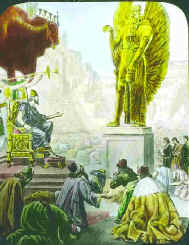
Nebuchadnezzar's Image
on the Plains of Dura |
The
story of the three Hebrews is given to encourage the saints in preparation for this
anticipated rise of the "image of the beast."
Nebuchadnezzar built a ninety-foot golden image on the plains of Dura, which
was alleged to be on the left bank of the Tigris.
Daniel 3:1-30
|
What makes this event significant was that it required every one of all
the provinces, especially people of importance, to worship at its dedication. It was not a
general shrine which people worshiped at will. This was to be initially worshiped by
command. Worship was not optional.
This golden image needed credibility, and the best way to get that was
by command. The punishment for failure to do so was very clear (Daniel 3:6). Shadrach,
Meshach and Abednego had been newly promoted to positions of power at Daniel’s
request. Their insubordination would reflect badly on Daniel.
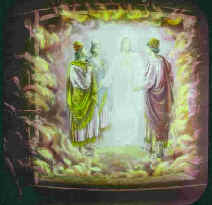
Shadrach, Meshach and Abednego
in the Fiery Furnace |
We know the story of how these three Hebrews refused to bow or bend.
They could not and they would not bow down to this image. The furnace
was heated to seven times its normal heat to accommodate the king’s anger.
They were thrown bound into the furnace and to everyone’s
shock and amazement they did not burn. One like the Son of God appeared with them in the
fire.
They came out unscathed without even the smell of fire. The only
things the fire burned were their bonds.
|
The three Hebrews emerged victorious over the "image"
experience. Not only so, they were promoted in the province of Babylon. Had the three
Hebrews bowed to the image they would have saved their lives, but lost the honor of
serving the living God.
Consider that thousands of people are sacrificing their lives daily on
remote battlefields. Countless thousands die unwillingly, just being victims of
circumstances. Death comes to all, sooner or later, so why should a consecrated Christian
be unwilling to put his life on the line?
Of course, this is easy to say, and usually compromises come because
there is an easy alternative to making the supreme sacrifice. Yes, and perhaps a noble
rationalization is presented that obedience would interfere with the sacrifices we are
making. However, obedience is "better than sacrifice."
We see a common lesson emerging.
The three Hebrews came out of the furnace with full
recognition that they served the living God.
Elijah, in his last three exchanges with King Ahaziah
demonstrated three times to the king and his company of fifty soldiers that he was a
"man of God" (2 Kings 1:9-16). A lot of people recognized Elijah’s
relationship to God.
Herod also "feared the multitude, because they counted him [John
the Baptist] a prophet" (Matthew 14:5).
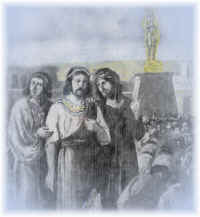
Shadrach, Meshach and Abednego |

Elijah |

John the Baptist |
We have three lessons here portraying an end time condition.
All of them confirm the fact that the Lord’s faithful saints will be recognized as
representing God.
Bro. Russell suggests that one of the ways that the tares would
be burned is by the fact that they would recognize the "real church of Christ."
(Reprint 5951)
All this adds up to a condition where the saints by their refusal to
compromise distinguish themselves before the world as servants of God. The Revelation
story goes on to show that the saints not only distinguish themselves, but that the Lord
will engage them to finish the last features of the harvest.

"Them That Had Gotten the
Victory
over the Beast and over His Image"
"And I saw as it were a sea of glass mingled with fire: and them that had gotten
the victory over the beast, and over his image, and over his mark, and over the number of
his name, stand on the sea of glass, having the harps of God." Revelation
15:2
Earlier the saints had been warned not to yield to the
"beast" or "its image." The time then comes when the "image of
the beast" is formed and vitalized. The story then goes beyond that time to when they
threaten that all must bow down or face the consequences.
At last this verse takes us to the time when the saints emerge
victorious, having refused to bow or bend or burn. They stand as known and recognized as
servants of God. The "spirit and power" of the Elijah class will then be seen to
be on them. A class here emerges victorious while still in the flesh, but recognized as a
part of those who have the "Father’s name written in their foreheads"
(Revelation 14:1).
At last a class that has distinguished itself by unswerving loyalty
to God and His truth here emerges as separate and distinct from a host of professing
Christians.
"Then shall ye return, and discern between the righteous and the wicked,
between him that serveth God and him that serveth him not."
Malachi 3:18
Pluralism will here have an end. Anybody today can still claim to
serve the Lord. They can teach anything and do anything, and none dare say what is right
and what is wrong. The servants of truth and the servants of error may not be
distinguished. That would be politically incorrect.
 |
However, God
has always known those who are His.
God will ultimately cause the righteous to "shine
forth as the sun in the kingdom of their Father."
(Matthew 13:43)
God’s called and chosen ones shall emerge separate and distinct, shining
as the "sun in the kingdom of their Father."
|
If there is a God in heaven, this is surely how matters must
eventuate. This will all come as a bitter surprise and disappointment to many in
Christendom.

And They Sing the Song
of "Moses" and the "Lamb"
"And they sing the song of Moses the servant of God, and the song of the Lamb,
saying, Great and marvelous are thy works, Lord God Almighty; just and true are thy ways,
thou King of saints.
"Who shall not fear thee, O Lord, and glorify thy name? For thou only art holy:
for all nations shall come and worship before thee; for thy judgments are made
manifest." Revelation 15:3, 4
Those who had gotten the "victory" over the
"beast" and its "image" are said to stand on or over the "sea of
glass," while below they view the "fire" [fiery judgments of the Lord].
Like the Hebrews, these standing on the "sea of glass" know how to be tested in
the fire and to come forth as gold. However, those beneath the "sea of glass"
are ill prepared for what shall befall them.
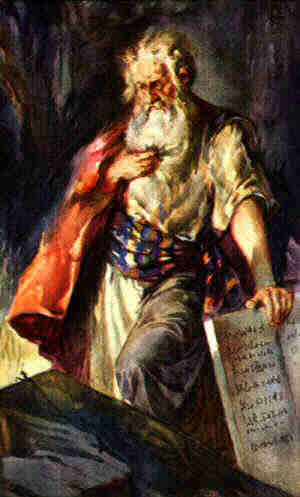
|
The "Song of Moses" refers to the song Moses sang the day he died, recorded in
Deuteronomy 32.
(See "The Song of Moses and the Lamb.")
The Song of Moses tells how God judges his people and finally how he
judges the enemies of his people.
|
The Lamb has been engaged in a similar work throughout the age.
However, at the end of the age the Lamb will finalize judgment on the "beast"
and its "image." It is important that all understand the righteousness of God in
these judgments. That is why those who have gotten the victory over the "beast"
and its "image" sing:
"Who shall not fear thee, O Lord, and glorify thy name? For thou only art
holy: for all nations shall come and worship before thee; for thy judgments are made
manifest."
They know how to suffer injustice and can truly appreciate God’s true justice.